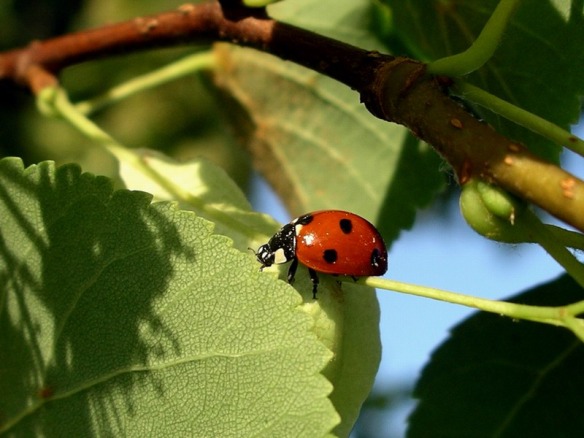
Photo courtesy of Michael Botos – http://www.botos.com/weekly/ladybugs.html
Lady bugs are awesome in general, but amazing when it comes to your garden. These little beauties love to snack on aphids, mites, and other nasty little soft bodied larvae that want to destroy all your hard work by slowly killing your beloved plants. That, and they are adorable.
Since having lady bugs living in your garden can help keep some of those destructive pest populations under control and is just plain awesome, what should you do to make that happen? First off, try and attract them to your garden. This is a good option if it is the first of the Spring season when the pests aren’t really an issue yet, or if you don’t really have a pest problem, but want to help prevent developing one by inviting the lady bugs to set up shop in your garden and eat up any bad pests as they arrive. How do you do that? Create a safe place for your lady bugs to live and make sure they have water to drink and tasty pollen to eat. Give them those things and they will be hanging out in your garden ready to pounce on any aphids or mites that decide your garden looks nice to them, too.
Housing: Lady bugs need a little cover…a nice safe place where birds and other predators can’t easily spot them. Mulch, foliage, tall grass, dense plants, etc… Or you can go and get all cute about it like I did and build a little lady bug house and hang it in your garden.
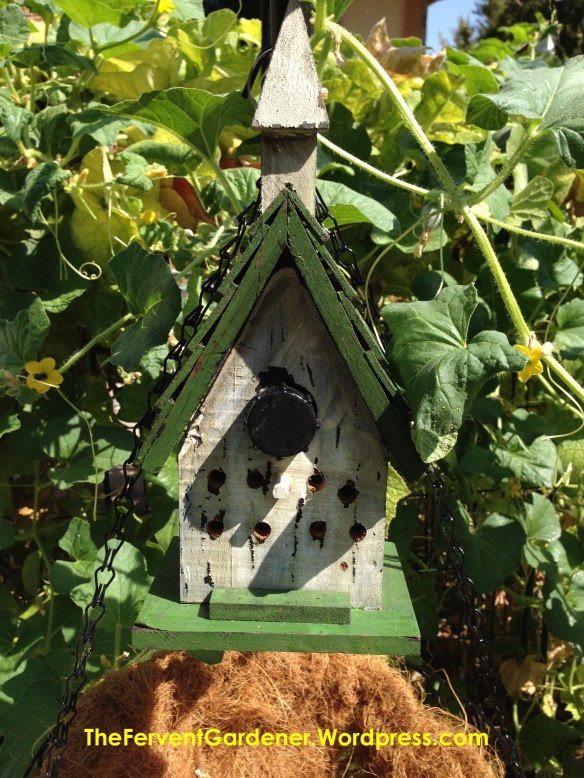 I took a little bird house I had in the garage, covered the larger hole that was meant for birds (since part of what you are trying to do is keep the birds AWAY from your lady bugs), drilled smaller holes the lady bugs could use to crawl in and out, and filled the inside with straw. A few months after hanging this in my garden last year, I started spotting lady bugs climbing around on it, and this year, I saw lady bug larvae on it, so I am going to call it a success.
I took a little bird house I had in the garage, covered the larger hole that was meant for birds (since part of what you are trying to do is keep the birds AWAY from your lady bugs), drilled smaller holes the lady bugs could use to crawl in and out, and filled the inside with straw. A few months after hanging this in my garden last year, I started spotting lady bugs climbing around on it, and this year, I saw lady bug larvae on it, so I am going to call it a success.
Water: You need some source of water that the lady bugs can use. It doesn’t need to be a large source, and you don’t want something that will just stagnate and invite mosquitoes to move in and start having babies. I have a few misters in my garden that water certain areas and leave a few nice puddles of water every morning. The potted plants on the patio inside the garden area have saucers that overflow a bit each day to keep the water fresh, but collect enough to feed the small community of beneficials living out there. If you don’t have a naturally occurring source of water, you could create one or set out small saucers of water – just make sure you freshen the water frequently.
Pollen: FLOWERS!! Flowers in your vegetable garden are a good idea all the way around. Many of them deter bad bugs, and attract and feed the good ones. And then there’s the part where they are lovely to look at and smell nice. Having the right flowers in your veggie garden will draw the lady bugs to the area in the first place, and then when they see all the other lovely accommodations you’ve made for them, they might just stick around and settle down for a while. They like lots of different kinds of flowers: dill, fennel, yarrow, zinnias, cosmos. My personal favorites, and the ones I have in my garden each year are Alyssum, Sunflowers, Peas and Marigolds.
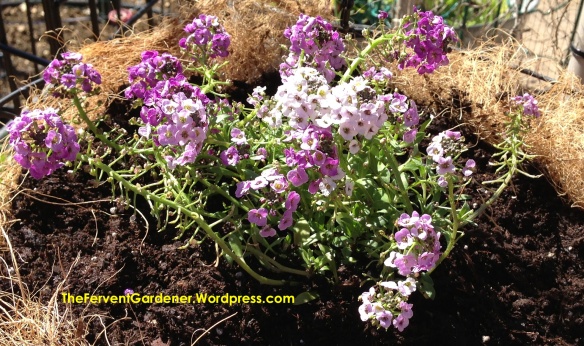 Alyssum is a sweet little flower that comes various shades that is low growing. Not only do lady bugs find this flower delicious, but so do the pollinators like bees and butterflies. I have this in a hanging basket on the edge of my garden – a tempting treat to draw lady bugs and the pollinators to my garden.
Alyssum is a sweet little flower that comes various shades that is low growing. Not only do lady bugs find this flower delicious, but so do the pollinators like bees and butterflies. I have this in a hanging basket on the edge of my garden – a tempting treat to draw lady bugs and the pollinators to my garden.
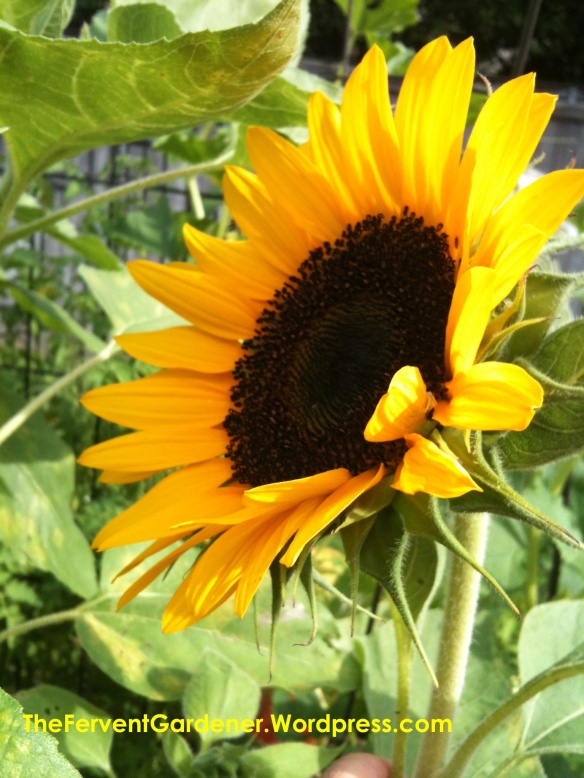 Sunflowers are a fun addition to the garden. If you plant a tall variety, they will tower over your garden during the peak of the summer with their bright happy faces. Much like the Alyssum, bees love these flowers, too, and will be pleased you planted them. If you plant them near your cucs, it can improve the cuc’s flavor – a nice prize for feeding the bees and lady bugs. And one more happy benefit of planting this sunny flower for your lady bugs is that you can harvest and eat the seeds!
Sunflowers are a fun addition to the garden. If you plant a tall variety, they will tower over your garden during the peak of the summer with their bright happy faces. Much like the Alyssum, bees love these flowers, too, and will be pleased you planted them. If you plant them near your cucs, it can improve the cuc’s flavor – a nice prize for feeding the bees and lady bugs. And one more happy benefit of planting this sunny flower for your lady bugs is that you can harvest and eat the seeds! Yummy!
Yummy!
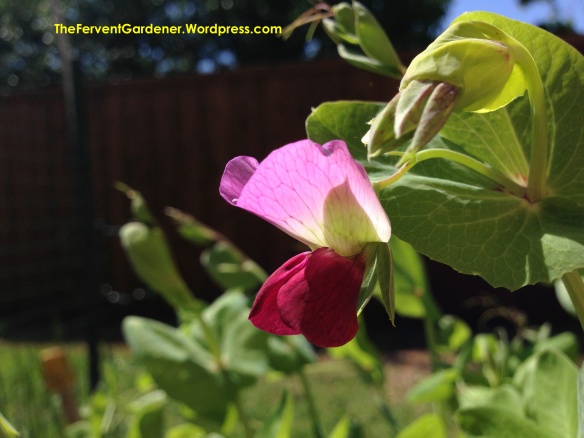 Pea plants form sweet little white flowers that turn into pea pods – or in the case of the picture above, purple flowers that become purple podded peas. Lady bugs love to snack on the pollen in these delicate little flowers.
Pea plants form sweet little white flowers that turn into pea pods – or in the case of the picture above, purple flowers that become purple podded peas. Lady bugs love to snack on the pollen in these delicate little flowers.
And then, of course, you get peas out of the deal. What a delicious bonus!
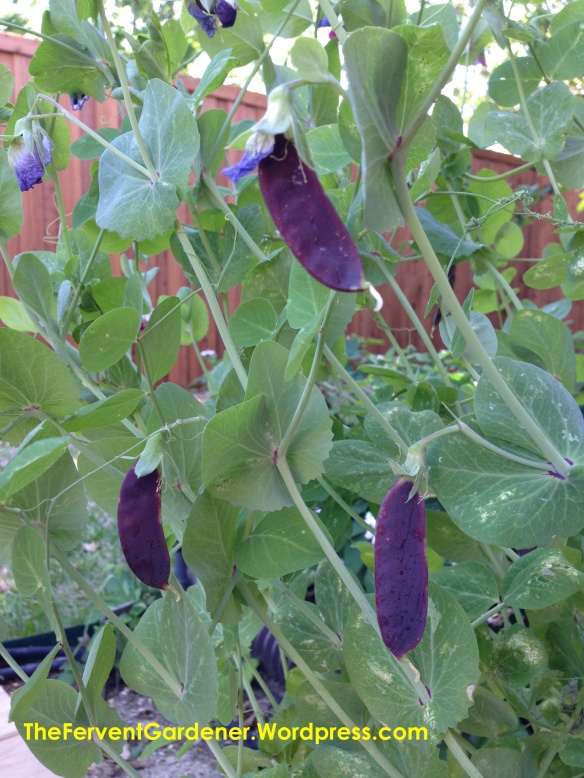 Now let’s talk about Marigolds.
Now let’s talk about Marigolds.
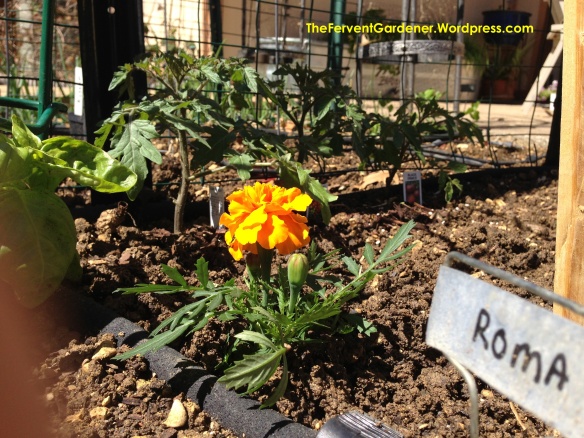 I consider these little guys one of the powerhouses in my fight against garden pests. One year my tomato plants were devastated by aphids. I was heartbroken. In my desperate search to find a solution, I read that marigolds help protect your tomatoes, and other plants, from the evil aphid. I tried them the next year and it worked. Now I plant these mighty warriors around the base of all my tomato plants every year…and have no issues with aphids at all! Then you have the added benefit that they are one of the pollens your lady bugs are fond of – everybody wins.
I consider these little guys one of the powerhouses in my fight against garden pests. One year my tomato plants were devastated by aphids. I was heartbroken. In my desperate search to find a solution, I read that marigolds help protect your tomatoes, and other plants, from the evil aphid. I tried them the next year and it worked. Now I plant these mighty warriors around the base of all my tomato plants every year…and have no issues with aphids at all! Then you have the added benefit that they are one of the pollens your lady bugs are fond of – everybody wins.
If you plant the tasty flowers, provide water and a place to live, hopefully the lady bugs will show up all on their own. But if you haven’t managed to attract them naturally, and find you are having a pest problem they can help with, you may need to pop down to your neighborhood organic nursery and pick up a little tub of them to release in your garden.
A few words about this:
1. If your pest problem is truly out of control, the lady bugs may enjoy the feast, but it probably won’t be in time to save your plants.
2. Once you release the large number of lady bugs that come in the container, you still have to have an environment where they want to stay. If there isn’t sufficient food, water and shelter, they will just head on out as soon as they can. Many many of them will leave anyway, but if your space is lovely to them, hopefully enough will stay to help combat your pest problem.
That said…let’s release some lady bugs! Keep the tub in the refrigerator until you are ready.
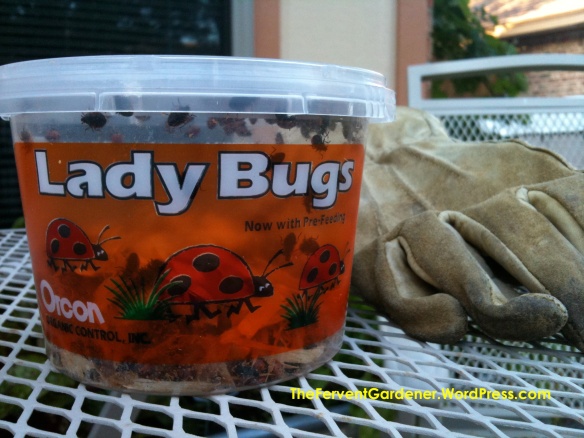 Wait until evening, and then water your garden well so there will be plenty of water for them to drink as they warm up and start moving around the space. I have read in several places that one way to get them to stay in the garden and not fly off right away is to spray them with sugar water so they will be too sticky to fly off and will already like your garden and want to stay by the time they can fly – I’ve never done that and have no idea if it works or not.
Wait until evening, and then water your garden well so there will be plenty of water for them to drink as they warm up and start moving around the space. I have read in several places that one way to get them to stay in the garden and not fly off right away is to spray them with sugar water so they will be too sticky to fly off and will already like your garden and want to stay by the time they can fly – I’ve never done that and have no idea if it works or not.
Once you take them out of the fridge and open the tub, they will start to warm up and move around.
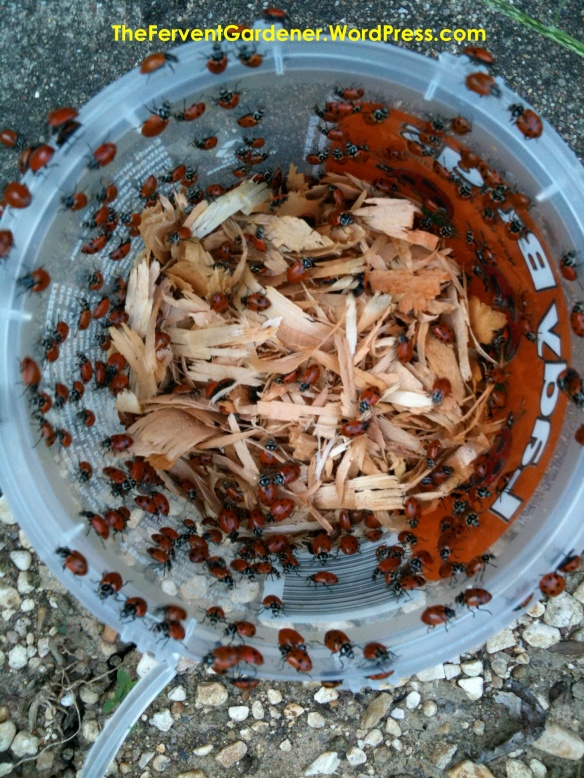 My approach was to walk around the garden and sprinkle them in different places so there wouldn’t be too many in one spot competing for food and water.
My approach was to walk around the garden and sprinkle them in different places so there wouldn’t be too many in one spot competing for food and water.
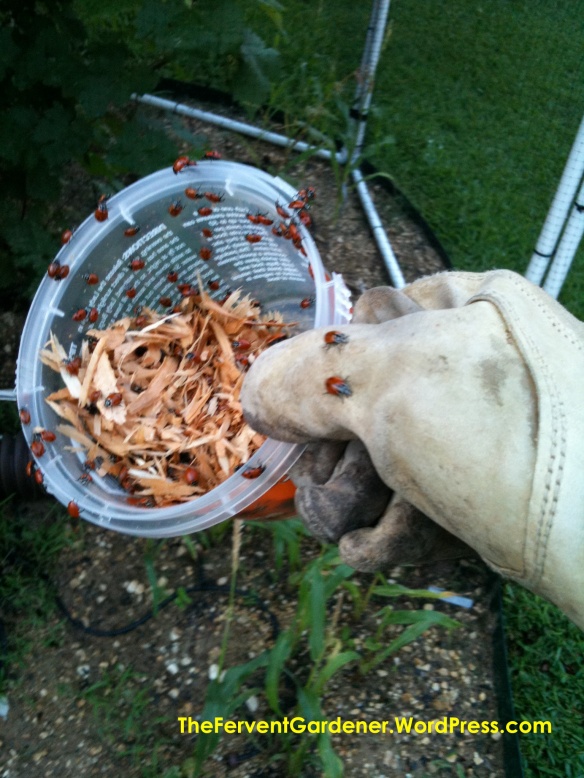 Warning: they WILL crawl out of the tub and on to you – like something out of a horror film. Since they don’t bite or do anything harmful, this isn’t a big deal unless bugs crawling on you freak you out. Luckily someone had warned me about this part and I had prepared myself emotionally. They are adorable, after all.
Warning: they WILL crawl out of the tub and on to you – like something out of a horror film. Since they don’t bite or do anything harmful, this isn’t a big deal unless bugs crawling on you freak you out. Luckily someone had warned me about this part and I had prepared myself emotionally. They are adorable, after all.
 Once all the lady bugs have been released into the garden. Find yourself a comfy spot to sit down…and wait for all the lady bugs that made it inside your clothes, to wander back out.
Once all the lady bugs have been released into the garden. Find yourself a comfy spot to sit down…and wait for all the lady bugs that made it inside your clothes, to wander back out.
At this point, the ladybugs should start doing their thing – wandering around your garden chowing down on tasty treats like aphids. Two days after the batch pictured below got to snacking, I couldn’t find a single aphid left in the garden. Good job, Ladybugs!
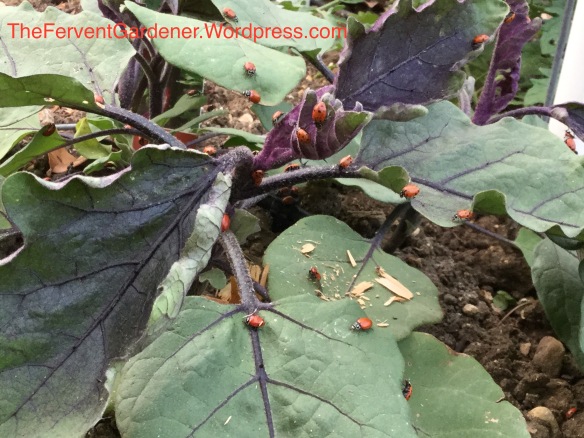
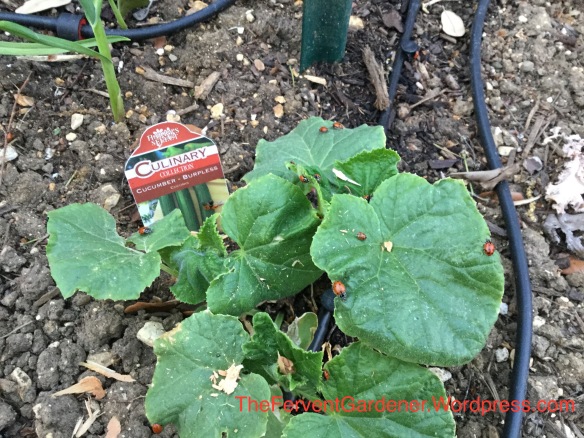
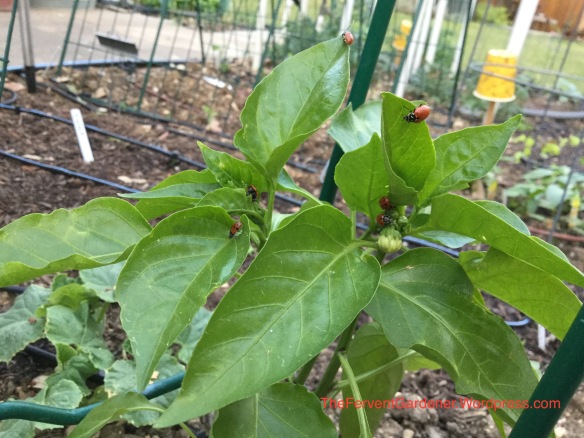
If you have been successful in getting a few lady bugs to make their home in your garden space, then it is very important that you learn to recognize not just the adults, but the eggs and larvae too. You certainly don’t want to undo all your good work by accidentally squishing the eggs or freaking out and killing the larvae as they bop around on your plants.
Here are a few photos courtesy of Michael Botos (http://www.botos.com/weekly/ladybugs.html) that will show you what your lady bugs look like before they are all grown up.
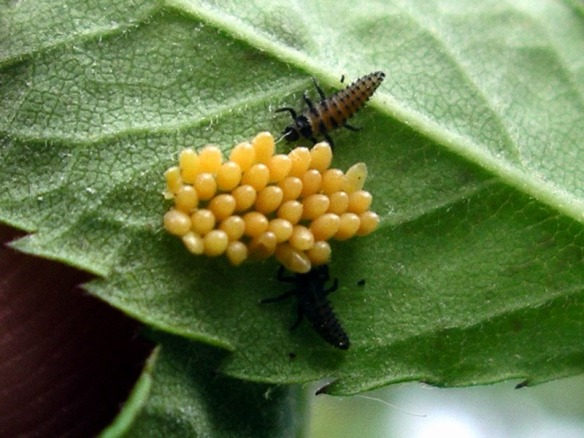
Photo courtesy of Michael Botos (http://www.botos.com/weekly/ladybugs.html)
Lady bug eggs are bright yellow ovals that are clustered together and standing on one end. And the larvae look like ugly little alligators.
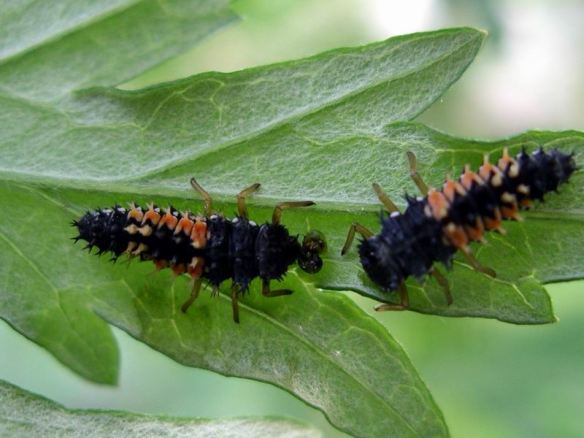
Photo courtesy of Michael Botos (http://www.botos.com/weekly/ladybugs.html)
If you see these little guys in your garden you will know you have done a good job making a happy place for lady bugs to settle in and build a family. Hooray for you!
The last point I would like to make about lady bugs concerns pesticides. If you are looking to control pests with lady bugs, then chances are good you are already committed to an organic approach in your garden. But in case you are tempted to use pesticides, keep in mind that they will kill your lady bugs and other beneficials as well as the bad bugs you were trying to get rid of.
Hope this helps you lure and keep these beautiful little aphid eaters in your garden!

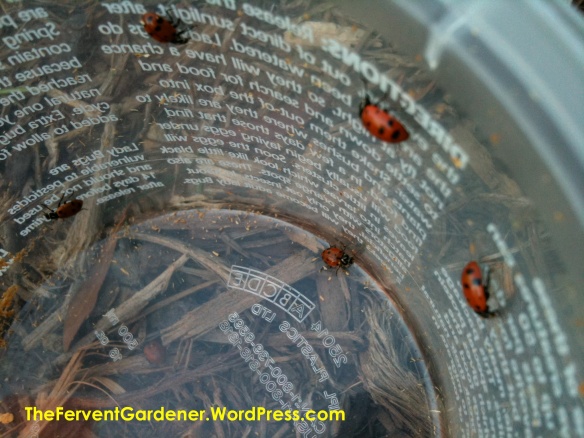
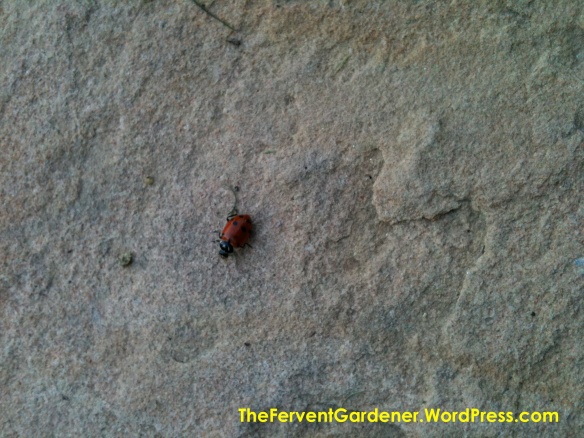
This is my favorite post so far. I’ve always heard about the value of having them, what they do and where to buy them, but never how to provide for them. And good job with the larvae identification as many people have no idea what they will become; they are scary looking. I am eager to build a lady bug nest. What fun!
Great primer on companion plantings, as well. Didn’t know the bit about the cucumbers.
Thanks, Kellee! I was trying to provide a lot of useful info, but not overload anyone. Glad I hit the right mark with you!
Also, have you gotten the invasive variety that does, in fact, bite? They are more of an orangy-red and are out competing the natives due to their aggressive nature.
Wow. No. I haven’t seen those, thank goodness. The ones I have managed to attract this year are the standard variety, as are most of the ones that you buy at the nurseries.